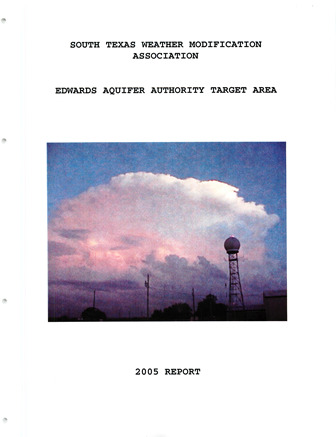South Texas Weather Modification Association Edwards Aquifer Authority Target Area 2005 Report

| Summary |
|
2005 marked the fourth year of operations for the Edwards Aquifer Authority (EAA) by the STWMA. Once again, N57AA was stationed at Stinson Field (SSF) in south San Antonio. Two of our pilots, Ron Merks and Mickey Chadwell, were stationed there. They worked along with Jim Transue and Tim Pickens, stationed at Pleasanton, and Larry Dement, stationed at Kenedy. N57AA did not fly as much this season due to flare rack problems, but Jim Transue and N8847P were able to fly numerous seeding missions in the EAA target area, henceforth referred to as the target area. 2005 turned out to be a good year for seeding in the target area, with 25 days of seeding. This compares with 20 days of seeding in 2004, 22 days in 2003, and 8 days in 2002. May saw a few days with seedable clouds, but was quieter than usual. June was incredibly disappointing, with no seeding missions taking place due to high pressure sitting over the area, effectively capping the convective potential. July exhibited a dramatic swing from June, with seeding taking place on 11 days within the target area. The busier weather pattern continued into August, with seeding missions taking place on seven days. Things began to wind down as fall approached, with only three days of seeding in September, and two in October. Despite the increase in convective activity over last year, rainfall amounts were significantly less in 2005, with some areas reporting rainfall deficits by the end of the year in excess of ten inches; this was mainly over Bexar County. Areas a bit further west over Medina and Bandera counties saw rainfall amounts closer to normal, but still on the dry side. A brief discussion on the meteorological perspective of the weather in summer 2005, along with seeding events will be presented later in the report. Once the season concluded, Archie Ruiz, who works for Active Influence performing radar evaluations for the Texas weather modification projects, completed the radar evaluation of the program. Once again, the analysis shows that seeding may have produced favorable increases in rainfall, with apparent lifetime extensions in the seeded clouds along with other positive results. These numbers are presented and discussed towards the end of the report. |
Search for Documents
Advance Search
Explore EAA's Scientific Reports
- All Reports
- Water Resources Planning and Management
- Floods and Drought
- Water Quality
- Climatology
- Surface Water / Groundwater Relationship
- Biology
- Springs, Groundwater Discharge
- Archaeology
- RZ Protection
- Aquifer Levels
- Remote Sensing
- Precipitation
- Overview Studies
- Modeling
- Hydrology and Hydrogeology
- History
- Groundwater Recharge, Recharge Zone
- Groundwater Movement
- Geomorphology and Caves
- Weather Modification
- Geology
- Water Use and Conservation
- Geochemistry
